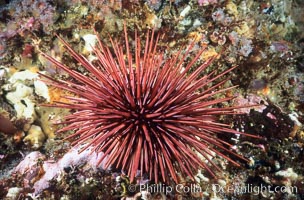
Red urchin on rocky California reef.
Species: Red urchin, Strogylocentrotus franciscanus
Location: California
Image ID: 03801
Species: Red urchin, Strogylocentrotus franciscanus
Location: California
Image ID: 03801
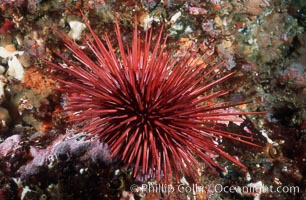
Red urchin on rocky California reef.
Species: Red urchin, Strogylocentrotus franciscanus
Location: California
Image ID: 03802
Species: Red urchin, Strogylocentrotus franciscanus
Location: California
Image ID: 03802
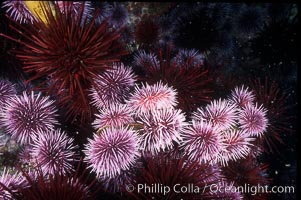
Purple and red urchins.
Species: Purple urchin, Strogylocentrotus franciscanus, Strongylocentrotus purpuratus
Location: Santa Barbara Island, California
Image ID: 04724
Species: Purple urchin, Strogylocentrotus franciscanus, Strongylocentrotus purpuratus
Location: Santa Barbara Island, California
Image ID: 04724
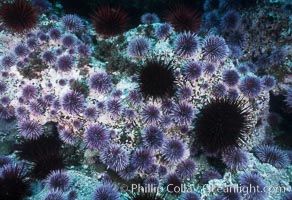
Purple and red urchins.
Species: Purple urchin, Strogylocentrotus franciscanus, Strongylocentrotus purpuratus
Location: Santa Barbara Island, California
Image ID: 04727
Species: Purple urchin, Strogylocentrotus franciscanus, Strongylocentrotus purpuratus
Location: Santa Barbara Island, California
Image ID: 04727
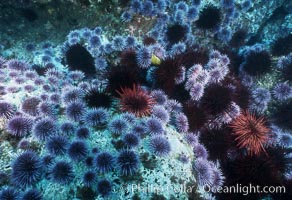
Purple and red urchins.
Species: Purple urchin, Strogylocentrotus franciscanus, Strongylocentrotus purpuratus
Location: Santa Barbara Island, California
Image ID: 04730
Species: Purple urchin, Strogylocentrotus franciscanus, Strongylocentrotus purpuratus
Location: Santa Barbara Island, California
Image ID: 04730
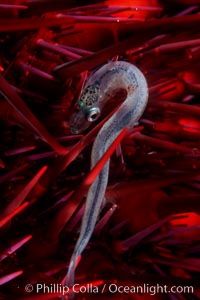
Small fish trapped in spines of unidentified urchin.
Location: San Miguel Island, California
Image ID: 07016
Location: San Miguel Island, California
Image ID: 07016
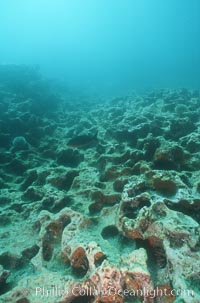
Urchin holes on rocky reef, Albany.
Location: James Island, Galapagos Islands, Ecuador
Image ID: 01885
Location: James Island, Galapagos Islands, Ecuador
Image ID: 01885
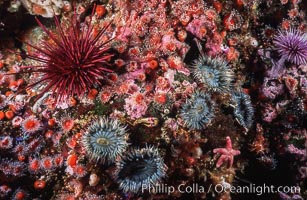
Red urchin, strawberry anemones and aggregating anemones on rocky California reef.
Species: Red urchin, Anthopleura elegantissima, Corynactis californica, Strogylocentrotus franciscanus
Location: California
Image ID: 03798
Species: Red urchin, Anthopleura elegantissima, Corynactis californica, Strogylocentrotus franciscanus
Location: California
Image ID: 03798
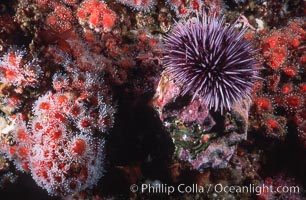
Purple urchin and strawberry anemones on rocky California reef.
Species: Purple urchin, Corynactis californica, Strongylocentrotus purpuratus
Location: California
Image ID: 03799
Species: Purple urchin, Corynactis californica, Strongylocentrotus purpuratus
Location: California
Image ID: 03799
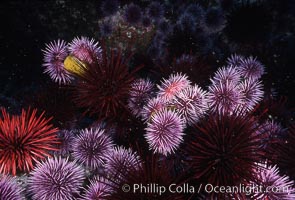
Purple and red urchins.
Species: Purple urchin, Strogylocentrotus franciscanus, Strongylocentrotus purpuratus
Location: Santa Barbara Island, California
Image ID: 04726
Species: Purple urchin, Strogylocentrotus franciscanus, Strongylocentrotus purpuratus
Location: Santa Barbara Island, California
Image ID: 04726
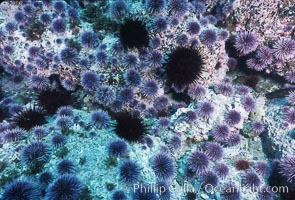
Purple and red urchins.
Species: Purple urchin, Strogylocentrotus franciscanus, Strongylocentrotus purpuratus
Location: Santa Barbara Island, California
Image ID: 04728
Species: Purple urchin, Strogylocentrotus franciscanus, Strongylocentrotus purpuratus
Location: Santa Barbara Island, California
Image ID: 04728
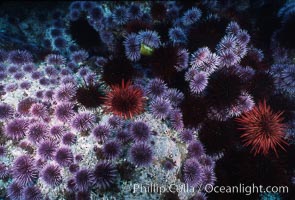
Purple and red urchins.
Species: Purple urchin, Strogylocentrotus franciscanus, Strongylocentrotus purpuratus
Location: Santa Barbara Island, California
Image ID: 04729
Species: Purple urchin, Strogylocentrotus franciscanus, Strongylocentrotus purpuratus
Location: Santa Barbara Island, California
Image ID: 04729
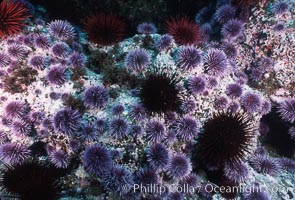
Purple and red urchins.
Species: Purple urchin, Strogylocentrotus franciscanus, Strongylocentrotus purpuratus
Location: Santa Barbara Island, California
Image ID: 04731
Species: Purple urchin, Strogylocentrotus franciscanus, Strongylocentrotus purpuratus
Location: Santa Barbara Island, California
Image ID: 04731
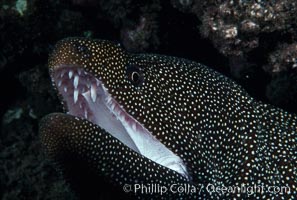
Purple sea urchins on rocky reef amid kelp forest.
Image ID: 05113
Image ID: 05113
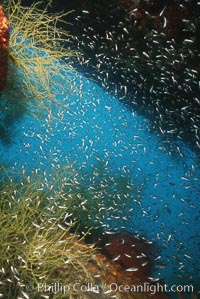
Purple sea urchins on rocky reef amid kelp forest.
Image ID: 05270
Image ID: 05270
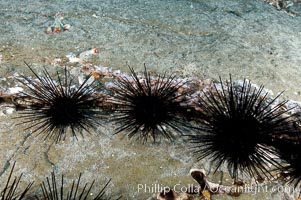
Unidentified marine urchins in a rock crevice.
Location: Guadalupe Island (Isla Guadalupe), Baja California, Mexico
Image ID: 09577
Location: Guadalupe Island (Isla Guadalupe), Baja California, Mexico
Image ID: 09577
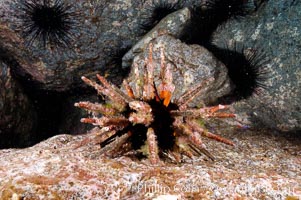
Unidentified marine urchin.
Location: Guadalupe Island (Isla Guadalupe), Baja California, Mexico
Image ID: 09579
Location: Guadalupe Island (Isla Guadalupe), Baja California, Mexico
Image ID: 09579
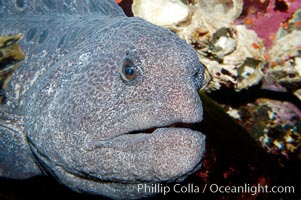
Wolf eel, although similar in shape to eels, is cartilaginous and not a true fish. Its powerful jaws can crush invertibrates, such as spiny sea urchins. It can grow to 6 feet (2m) in length.
Species: Wolf eel, Anarrhichthys ocellatus
Image ID: 09835
Species: Wolf eel, Anarrhichthys ocellatus
Image ID: 09835
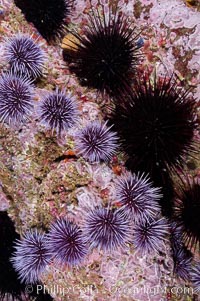
Purple and black sea urchins on a rocky reef. The urchins will clear all kelp off a reef if their population is not held in balance by predictors. Santa Barbara Island.
Species: Purple urchin, Strongylocentrotus purpuratus
Location: Santa Barbara Island, California
Image ID: 10142
Species: Purple urchin, Strongylocentrotus purpuratus
Location: Santa Barbara Island, California
Image ID: 10142
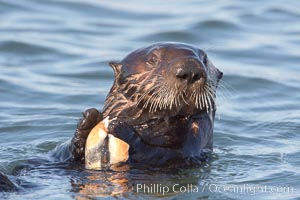
A sea otter eats a clam that it has taken from the shallow sandy bottom of Elkhorn Slough. Because sea otters have such a high metabolic rate, they eat up to 30% of their body weight each day in the form of clams, mussels, urchins, crabs and abalone. Sea otters are the only known tool-using marine mammal, using a stone or old shell to open the shells of their prey as they float on their backs.
Species: Sea otter, Enhydra lutris
Location: Elkhorn Slough National Estuarine Research Reserve, Moss Landing, California
Image ID: 21689
Species: Sea otter, Enhydra lutris
Location: Elkhorn Slough National Estuarine Research Reserve, Moss Landing, California
Image ID: 21689
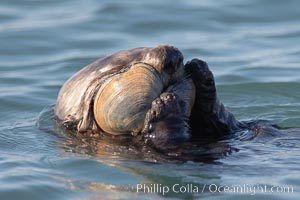
A sea otter eats a clam that it has taken from the shallow sandy bottom of Elkhorn Slough. Because sea otters have such a high metabolic rate, they eat up to 30% of their body weight each day in the form of clams, mussels, urchins, crabs and abalone. Sea otters are the only known tool-using marine mammal, using a stone or old shell to open the shells of their prey as they float on their backs.
Species: Sea otter, Enhydra lutris
Location: Elkhorn Slough National Estuarine Research Reserve, Moss Landing, California
Image ID: 21694
Species: Sea otter, Enhydra lutris
Location: Elkhorn Slough National Estuarine Research Reserve, Moss Landing, California
Image ID: 21694
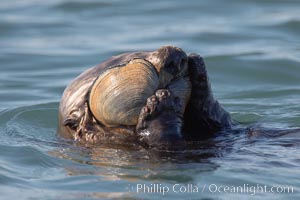
A sea otter eats a clam that it has taken from the shallow sandy bottom of Elkhorn Slough. Because sea otters have such a high metabolic rate, they eat up to 30% of their body weight each day in the form of clams, mussels, urchins, crabs and abalone. Sea otters are the only known tool-using marine mammal, using a stone or old shell to open the shells of their prey as they float on their backs.
Species: Sea otter, Enhydra lutris
Location: Elkhorn Slough National Estuarine Research Reserve, Moss Landing, California
Image ID: 21695
Species: Sea otter, Enhydra lutris
Location: Elkhorn Slough National Estuarine Research Reserve, Moss Landing, California
Image ID: 21695
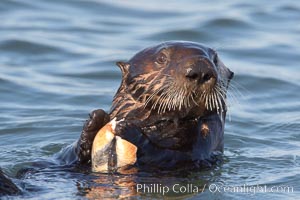
A sea otter eats a clam that it has taken from the shallow sandy bottom of Elkhorn Slough. Because sea otters have such a high metabolic rate, they eat up to 30% of their body weight each day in the form of clams, mussels, urchins, crabs and abalone. Sea otters are the only known tool-using marine mammal, using a stone or old shell to open the shells of their prey as they float on their backs.
Species: Sea otter, Enhydra lutris
Location: Elkhorn Slough National Estuarine Research Reserve, Moss Landing, California
Image ID: 21724
Species: Sea otter, Enhydra lutris
Location: Elkhorn Slough National Estuarine Research Reserve, Moss Landing, California
Image ID: 21724
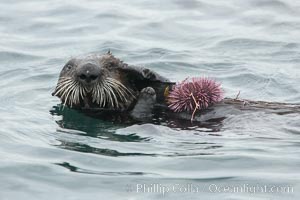
Sea otter rests on the ocean surface, grasping a purple sea urchin it has just pulled up off the ocean bottom and will shortly eat. Monterey.
Species: Sea otter, Enhydra lutris, Strongylocentrotus purpuratus
Location: Monterey, California
Image ID: 15067
Species: Sea otter, Enhydra lutris, Strongylocentrotus purpuratus
Location: Monterey, California
Image ID: 15067
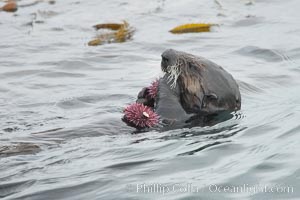
Sea otter rests on the ocean surface, grasping a purple sea urchin it has just pulled up off the ocean bottom and will shortly eat. Monterey.
Species: Sea otter, Enhydra lutris, Strongylocentrotus purpuratus
Location: Monterey, California
Image ID: 15068
Species: Sea otter, Enhydra lutris, Strongylocentrotus purpuratus
Location: Monterey, California
Image ID: 15068